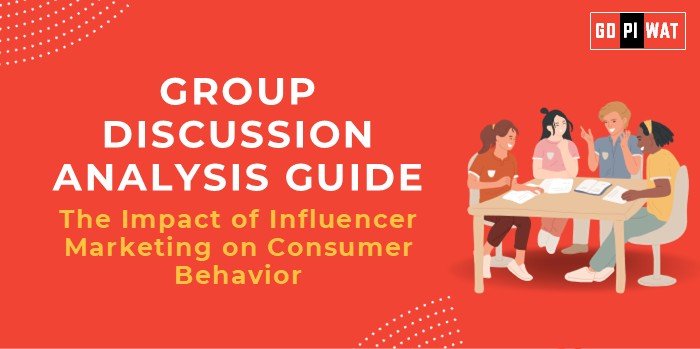📋 Group Discussion (GD) Analysis Guide: The Impact of Influencer Marketing on Consumer Behavior
🌐 Introduction to the Topic
- 💡 Opening Context: In a world driven by social media, influencer marketing has emerged as a powerful tool shaping consumer decisions. From promoting niche products to mainstream brands, influencers are redefining traditional marketing paradigms.
- 📜 Topic Background: Influencer marketing traces its roots to celebrity endorsements but has evolved with the rise of platforms like Instagram, TikTok, and YouTube. By 2024, the global influencer marketing industry is valued at over $21 billion, indicating its growing significance in business strategies.
📊 Quick Facts and Key Statistics
- 📈 Global Market Size (2024): $21.1 billion – Reflects exponential growth from $8 billion in 2019.
- 🤝 Consumer Trust: 63% of consumers trust influencers more than brand advertisements.
- 📊 Engagement Rates: Micro-influencers often see engagement rates up to 60% higher than mega-influencers.
- 💵 ROI Metrics: Businesses earn $5.20 for every $1 spent on influencer marketing.
👥 Stakeholders and Their Roles
- 🏢 Brands: Utilize influencers to penetrate new markets and strengthen brand loyalty.
- 🛍️ Consumers: Drive market trends by engaging with and trusting influencers.
- 📱 Influencers: Act as intermediaries shaping purchase behaviors through authentic content.
- 🌐 Platforms (Instagram, TikTok, YouTube): Facilitate collaborations and provide analytics for targeted campaigns.
🏆 Achievements and Challenges
✨ Achievements
- 🌟 Increased Brand Awareness: Influencers amplify visibility, with campaigns like Fenty Beauty showcasing inclusivity.
- 🤝 Enhanced Consumer Trust: Peer-like connections foster trust and credibility.
- 📊 Data-Driven Targeting: Platforms provide granular audience insights, maximizing campaign efficacy.
- 🌍 Global Reach: Influencers transcend geographical boundaries, tapping into diverse demographics.
⚠️ Challenges
- 🤔 Authenticity Issues: Concerns over fake followers and misleading endorsements undermine trust.
- ⚖️ Regulatory Compliance: Lack of clear guidelines on ad disclosures.
- 📉 Saturation Risk: Oversaturation leads to reduced engagement and audience fatigue.
🌍 Global Comparisons
- 🇺🇸 United States: Highly regulated, with FTC guidelines for transparency.
- 🇨🇳 China: Dominated by live-streaming influencers; strict e-commerce compliance laws.
- 🇮🇳 India: Fast-growing sector, with regional influencers driving vernacular engagement.
📚 Case Studies
- 🏃 Nike’s Collaboration with Cristiano Ronaldo: Leveraged global appeal to boost sales.
- 🌱 India’s Mamaearth Campaigns: Focused on authenticity, aligning with influencer values.
💬 Structured Arguments for Discussion
- 💪 Supporting Stance: “Influencer marketing bridges the gap between brands and consumers by leveraging trust.”
- ⚖️ Opposing Stance: “Over-commercialization of influencer content risks diminishing consumer trust.”
- 🤝 Balanced Perspective: “While effective, influencer marketing must balance authenticity with ethical transparency.”
📚 Effective Discussion Approaches
- 💡 Opening Approaches:
- 📊 “With $21 billion in 2024 revenue, influencer marketing redefines brand engagement.”
- 📜 “Mamaearth’s campaigns epitomize influencer marketing’s power in regional markets.”
- 🤔 Counter-Argument Handling:
- 📊 “While authenticity is a challenge, innovative tools like AI-driven follower audits can ensure credibility.”
- ⚖️ “Regulations like FTC guidelines in the U.S. serve as models for global standards.”
🔎 Strategic Analysis of Strengths and Weaknesses
- 💪 Strengths: High ROI, audience targeting, and global reach.
- 🛑 Weaknesses: Fake followers, saturation, and lack of regulation.
- 🌟 Opportunities: AI in influencer vetting, regional market penetration.
- ⚠️ Threats: Rising competition, consumer skepticism.
🎓 Connecting with B-School Applications
- 📊 Real-World Applications: Analyze the ROI of campaigns for marketing projects or research consumer psychology in digital marketing.
- ❓ Sample Interview Questions:
- 💡 “What role does influencer marketing play in brand loyalty?”
- 📚 “How would you assess the impact of micro-influencers versus macro-influencers?”
- 📝 Insights for B-School Students: Focus on evolving regulations, the ethics of influencer marketing, and its integration with AI for campaign optimization.


